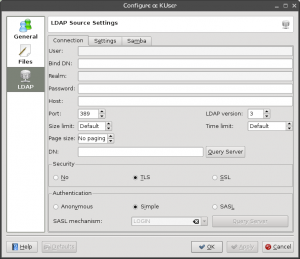KUser: Difference between revisions
(Markup edit) |
(formatting change) |
||
| (4 intermediate revisions by 4 users not shown) | |||
| Line 2: | Line 2: | ||
<translate> | <translate> | ||
<!--T:1--> | |||
{|class="tablecenter vertical-centered" | {|class="tablecenter vertical-centered" | ||
|[[Image:System-users.png|128px|center]]|| '''KUser is a tool for managing users and groups on your system''' | |[[Image:System-users.png|128px|center]]|| '''KUser is a tool for managing users and groups on your system''' | ||
| Line 7: | Line 8: | ||
<!--T:2--> | |||
{{info|Images are clickable, which displays the full-size image. You have to use the back-button of your browser to return.}} | {{info|Images are clickable, which displays the full-size image. You have to use the back-button of your browser to return.}} | ||
== Features == | == Features == <!--T:3--> | ||
<!--T:4--> | |||
*Add/Edit/Remove users | *Add/Edit/Remove users | ||
*Add/Edit/Remove groups | *Add/Edit/Remove groups | ||
*Password Management | *Password Management | ||
== Setup == | == Setup == <!--T:5--> | ||
''' | <!--T:6--> | ||
Once installed you can find it under <menuchoice> | '''KUser''' usually is not installed by default, so it has to be installed manually. '''KUser''' is part of the '''kdeadmin'''-package. | ||
Once installed you can find it under <menuchoice>Kickoff -> Applications -> System -> KUser</menuchoice> (<menuchoice>Kickoff -> System -> KUser</menuchoice> if you use the classic menu style) , or start it with '''KRunner''' (<keycap>Alt+F2</keycap>) typing {{Input|1=kuser}}. | |||
== Using KUser == | == Using KUser == <!--T:7--> | ||
After starting '''KUser''' a window opens containing two tabs: <menuchoice>Users</menuchoice> and <menuchoice>Groups</menuchoice>. | After starting '''KUser''' a window opens containing two tabs: <menuchoice>Users</menuchoice> and <menuchoice>Groups</menuchoice>. | ||
<!--T:8--> | |||
[[Image:kuser_main.png|thumb|300px|center]] | [[Image:kuser_main.png|thumb|300px|center]] | ||
== Users == | == Users == <!--T:9--> | ||
<!--T:10--> | |||
Double-clicking a user opens a dialog with several tabs. The amount of tabs is variable, depending on the type of the user storage system and whether quotas are being used. | Double-clicking a user opens a dialog with several tabs. The amount of tabs is variable, depending on the type of the user storage system and whether quotas are being used. | ||
==== User Info ==== | ==== User Info ==== <!--T:11--> | ||
* Modify the user-properties like <menuchoice>User-ID</menuchoice>, <menuchoice>Name</menuchoice>, <menuchoice> | <!--T:12--> | ||
* Modify the user-properties like <menuchoice>User-ID</menuchoice>, <menuchoice>Name</menuchoice>, <menuchoice>Address information</menuchoice> or set/change a <menuchoice>password</menuchoice> for example. You can also <menuchoice>deactivate an account</menuchoice>. | |||
<!--T:13--> | |||
[[Image:kuser_edit_user_userinfo.png|thumb|300px|center]] | [[Image:kuser_edit_user_userinfo.png|thumb|300px|center]] | ||
==== Password Management ==== | ==== Password Management ==== <!--T:14--> | ||
<!--T:15--> | |||
* Change password settings, like the time after which a password has to be changed, or set a time at which an account will expire. | * Change password settings, like the time after which a password has to be changed, or set a time at which an account will expire. | ||
<!--T:16--> | |||
[[Image:kuser_edit_user_password.png|thumb|300px|center]] | [[Image:kuser_edit_user_password.png|thumb|300px|center]] | ||
==== Groups ==== | ==== Groups ==== <!--T:17--> | ||
<!--T:18--> | |||
*Add or remove groups the user belongs to. | *Add or remove groups the user belongs to. | ||
<!--T:19--> | |||
[[Image:kuser_edit_user_groups.png|thumb|300px|center]] | [[Image:kuser_edit_user_groups.png|thumb|300px|center]] | ||
== Groups == | == Groups == <!--T:20--> | ||
<!--T:21--> | |||
Double clicking a <menuchoice>group</menuchoice> opens a dialog, where you can <menuchoice>change the name</menuchoice> of the group and <menuchoice>add/remove users</menuchoice> to/from a group. | Double clicking a <menuchoice>group</menuchoice> opens a dialog, where you can <menuchoice>change the name</menuchoice> of the group and <menuchoice>add/remove users</menuchoice> to/from a group. | ||
<!--T:22--> | |||
[[Image:kuser_groups_edit.png|thumb|300px|center]] | [[Image:kuser_groups_edit.png|thumb|300px|center]] | ||
<!--T:23--> | |||
{{warning|'''Be careful deleting anything, as it can harm your system seriously!'''}} | {{warning|'''Be careful deleting anything, as it can harm your system seriously!'''}} | ||
== Configure KUser == | == Configure KUser == <!--T:24--> | ||
Click <menuchoice>Settings -> Configure KUser</menuchoice> and you can set up defaults for creating a new user: | Click <menuchoice>Settings -> Configure KUser</menuchoice> and you can set up defaults for creating a new user: | ||
=== General === | === General === <!--T:25--> | ||
<!--T:26--> | |||
* set the <menuchoice>shell</menuchoice>, the <menuchoice>home path</menuchoice> or the <menuchoice>UID</menuchoice>. | * set the <menuchoice>shell</menuchoice>, the <menuchoice>home path</menuchoice> or the <menuchoice>UID</menuchoice>. | ||
* choose if a <menuchoice>home folder</menuchoice> will be created and if a <menuchoice>skeleton</menuchoice> (standard configuration files) will be copied to the home folder. | * choose if a <menuchoice>home folder</menuchoice> will be created and if a <menuchoice>skeleton</menuchoice> (standard configuration files) will be copied to the home folder. | ||
| Line 77: | Line 93: | ||
<!--T:27--> | |||
[[Image:kuser_settings_general.png|thumb|300px|center]] | [[Image:kuser_settings_general.png|thumb|300px|center]] | ||
=== Files === | === Files === <!--T:28--> | ||
<!--T:29--> | |||
* set default paths for password, group file, password shadow file and group shadow file. | * set default paths for password, group file, password shadow file and group shadow file. | ||
<!--T:30--> | |||
[[Image:kuser_settings_files.png|thumb|300px|center]] | [[Image:kuser_settings_files.png|thumb|300px|center]] | ||
=== LDAP === | === LDAP === <!--T:31--> | ||
<!--T:32--> | |||
* set preferences for users in a local network | * set preferences for users in a local network | ||
<!--T:33--> | |||
[[Image:kuser_settings_ldap.png|thumb|300px|center]] | [[Image:kuser_settings_ldap.png|thumb|300px|center]] | ||
<!--T:34--> | |||
{{Tip|In most cases you won't have to change the default settings, as they are sufficient for most users.}} | {{Tip|In most cases you won't have to change the default settings, as they are sufficient for most users.}} | ||
== More Information == | == More Information == <!--T:35--> | ||
*[http://docs.kde.org/stable/en/kdeadmin/kuser/ | <!--T:36--> | ||
*[http://docs.kde.org/stable/en/kdeadmin/kuser/index.html KUser Manual] | |||
<!--T:37--> | |||
[[Category:System]] | [[Category:System]] | ||
</translate> | </translate> | ||
Revision as of 16:15, 4 February 2013
 |
KUser is a tool for managing users and groups on your system |
Features
- Add/Edit/Remove users
- Add/Edit/Remove groups
- Password Management
Setup
KUser usually is not installed by default, so it has to be installed manually. KUser is part of the kdeadmin-package.
Once installed you can find it under ( if you use the classic menu style) , or start it with KRunner (Alt+F2) typing
kuser
.
Using KUser
After starting KUser a window opens containing two tabs: and .
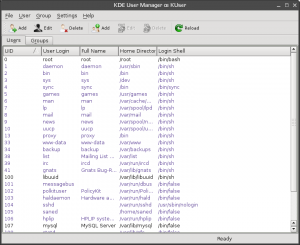
Users
Double-clicking a user opens a dialog with several tabs. The amount of tabs is variable, depending on the type of the user storage system and whether quotas are being used.
User Info
- Modify the user-properties like , , or set/change a for example. You can also .
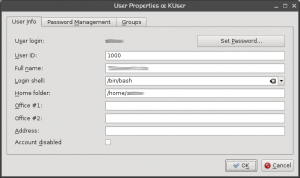
Password Management
- Change password settings, like the time after which a password has to be changed, or set a time at which an account will expire.
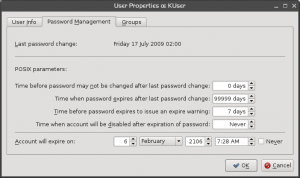
Groups
- Add or remove groups the user belongs to.
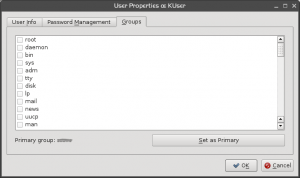
Groups
Double clicking a opens a dialog, where you can of the group and to/from a group.
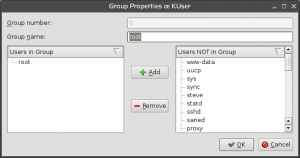
Configure KUser
Click and you can set up defaults for creating a new user:
General
- set the , the or the .
- choose if a will be created and if a (standard configuration files) will be copied to the home folder.
- set a , which creates a own personal group when a user is added and removes it, when the user is removed.
- set a .
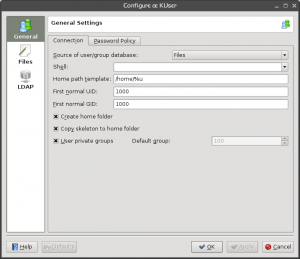
Files
- set default paths for password, group file, password shadow file and group shadow file.
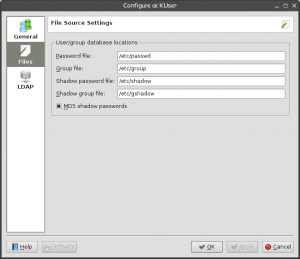
LDAP
- set preferences for users in a local network
